SUBJECTS
GRADE
Show Results
Weather in the Seasons
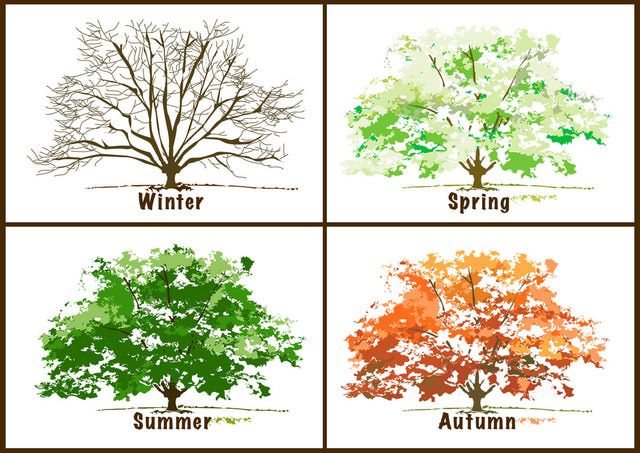
Lesson Summary
- Identify characteristics of weather.
- Create a weather forecast for a section of Vivaldi’s The Four Seasons.
- Create dance movements to represent weather.
Lesson Plan and Procedure
Lesson Key Facts
- Grade(s): K, 3
- Subject(s): Dance, Music, Science
- Duration of lesson: 60 minutes
- Author(s): Emily Soderborg and Miriam Bowen
Seasons and Weather
Divide the class into four groups by numbering off the students with numbers one to four. Have students with the same number sit together.
Teacher: Today we are going to have special group names, instead of being group one, group two, group three, or group four. Listen as I tell each group their name and see if you recognize these words.
Tell the first group that their group name is spring, the second that their name is summer, the third that their name is autumn, and the fourth that their name is winter.
Teacher: Who knows how the words I said to each group are connected? That’s right. Each of today’s group names is a season.
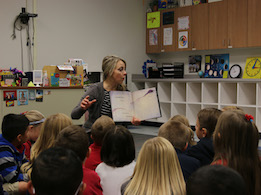 Read Let’s Explore Seasons by Henry Pluckrose (or another nonfiction book about seasons). Pause as you read, and ask questions about what the students understand from the book. Have each group repeat the name of their season as it appears in the book.
Read Let’s Explore Seasons by Henry Pluckrose (or another nonfiction book about seasons). Pause as you read, and ask questions about what the students understand from the book. Have each group repeat the name of their season as it appears in the book.
Teacher: What are the names of the seasons again? Say your season name when I point to your group. What season is it right now? How do we know it is that season? What can we observe around us that helps us know this?
Listen to and acknowledge student responses.
Teacher: One thing we can observe is the weather. But is weather the same as a season? No! Today, we are going to explore the many different types of weather within each season.
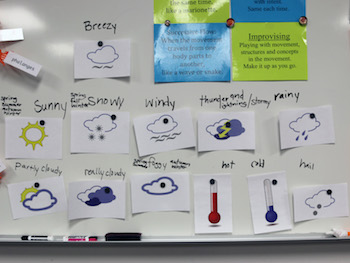 Teacher: What weather do you think of when you hear the term winter season? I think of snowy weather, but thankfully it doesn’t snow constantly all winter long. Can you imagine it snowing all day, every day, for the entire winter season? Luckily, there are other types of weather in the winter season. The difference between seasons and weather is that seasons are defined by weather patterns that we observe over several months, whereas weather can change from day to day, or even from hour to hour. And weather can vary depending on location. It might be snowy in Springville, but down in St. George it could be sunny. Even though each location is in the same season, the weather within the season can be very different. Let’s see how many different types of weather we can think of.
Teacher: What weather do you think of when you hear the term winter season? I think of snowy weather, but thankfully it doesn’t snow constantly all winter long. Can you imagine it snowing all day, every day, for the entire winter season? Luckily, there are other types of weather in the winter season. The difference between seasons and weather is that seasons are defined by weather patterns that we observe over several months, whereas weather can change from day to day, or even from hour to hour. And weather can vary depending on location. It might be snowy in Springville, but down in St. George it could be sunny. Even though each location is in the same season, the weather within the season can be very different. Let’s see how many different types of weather we can think of.
Make a list of the types of weather the students come up with. Show the weather symbols as they list types of weather.
Teacher: What seasons would each type of weather happen in?
Write the season or seasons next to the weather symbols to help students recognize that some types of weather happen in more than one season.
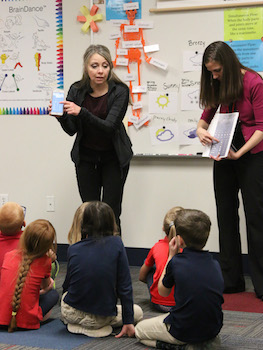 Teacher: What kind of weather do we have right now? Can we create a dance movement that represents the weather right now?
Teacher: What kind of weather do we have right now? Can we create a dance movement that represents the weather right now?
Model how to create a dance movement that represents that certain type of weather. Continue as needed by identifying the movement of one or two more of the students’ suggestions for types of weather.
Teacher: Who can tell me what kind of weather we had yesterday? Was there more than one type of weather? Can we show with our weather pictures a representation of the weather that happened all day yesterday? This looks like a weather forecast! A forecast is a prediction of coming weather. Have you ever looked at a forecast that showed what the weather would be like throughout the day and how the weather might change?
Show a picture of an hourly weather forecast (from a phone or computer).
Have students do a dance of yesterday’s forecast.
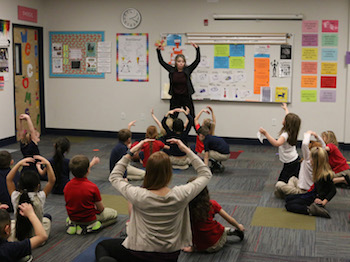

The Four Seasons
Teacher: Did you know that people have been paying attention to the seasons and the weather for a long time? One of these people was a man named Antonio Vivaldi, who lived in Italy from 1678 to 1741. (He was born about 100 years before America became a nation.)
Show a picture of Antonio Vivaldi to the students.
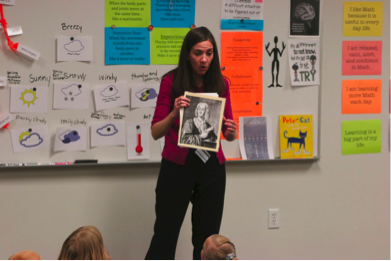
Teacher: Mr. Vivaldi had a special job. He was a composer, which means he wrote music. He wrote a piece of music called The Four Seasons. In this music he has sections labeled “Spring,” “Summer,” “Autumn,” and “Winter.” This music is very special because Vivaldi was one of the earliest composers who tried to make his music paint a picture or tell a story without using any words. He used different sounds to try to help us imagine what each season feels like.
Teacher: Can you think of a type of weather that happens in one of the seasons? How would you represent that type of weather with only sounds? Would you use high or low sounds? Fast or slow sounds? Loud or soft sounds? Is there a specific instrument you might use?
Teacher: Vivaldi used instruments to represent all kinds of weather, like a sunny day, a gentle breeze, a thunderstorm, a freezing cold wind, and lots of other types of weather. However, just to be sure that everyone listening to The Four Seasons knew what he was trying to represent in his music, in addition to the music itself, there were poems written, called sonnets, that specifically told about each part of the music.
(Teacher tip: The sonnets are included in the teacher’s listening guide. You can share these sonnets with the students as a language arts tie-in wherever it fits best in your schedule.)
Teacher: Within each of these The Four Seasons movements we can hear many different types of weather. It’s almost like he created a weather forecast like the one we made earlier, but he created his forecast with sounds instead of pictures. When we look at the forecast, does it have weather changing back and forth constantly? Not usually. That means we might have to listen to the music for a little while before we hear any changes in what the music might be representing. Listen for changes in the instruments or in musical qualities like high or low, fast or slow, and loud or soft. Let’s listen together to the first concerto, “Spring,” from Vivaldi’s The Four Seasons and see what weather we think we hear. Point to the weather symbols on the board, and I will arrange them into a forecast as you point to them. Listen carefully. We will talk about what we hear after the music finishes.
As a class, carefully listen to Allegro, the entire first movement of “Spring.” Have the students point to the individual weather symbols on the board they think the music is representing. You will need multiple copies of a few weather symbols used in “Spring, movement 1”: sunny, cloudy, stormy (thunder/lightning), rainy, and partly cloudy (optional). Talk as little as possible while the music is playing to allow the students to focus on listening to the music. Silently arrange the weather symbols on the board as the students point to them. It might seem like a long time to only listen, but because the students are trying to decide what type of weather the sounds represent, they stay focused.
If the students need more hands-on involvement, you could give them individual weather symbols to arrange (this would require making additional copies) or have them draw the forecast, using the weather symbols on the board as a reference, as they listen. After listening to the entire movement (3 minutes, 35 seconds), have the students discuss what they heard and see if the weather symbols need to be rearranged to match their decision. This weather forecast provides the students with the opportunity to map the musical form of the entire piece by using the weather symbols to show what they heard and the order they heard it in.
After the students have mapped out “Spring, movement 1: Allegro,” continue by helping them create dance movements for the different types of weather in the season. Explore the movement ideas without music, and when the students decide on specific dance movements, try the movements with the music.
Small Group Exploration of Seasons
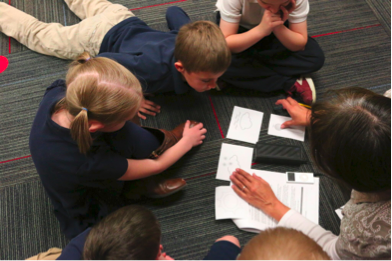
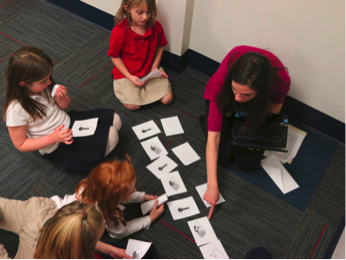
Teacher: We just listened to and created a forecast for spring. In groups we are now going to listen to and create forecasts for the other three seasons. Spring group, since we already listened to music for spring, we are going to divide you between the summer, autumn, and winter groups. Each group is going to listen to a movement from Vivaldi’s The Four Seasons that connects with the season group. Then you will create a weather forecast with weather symbols to share with other groups. You will need to listen carefully to the music and put the pictures in order according to what type of weather you think you hear in the music, listening for at least two different types of weather. You will then figure out how to show with your bodies the weather types that you heard.
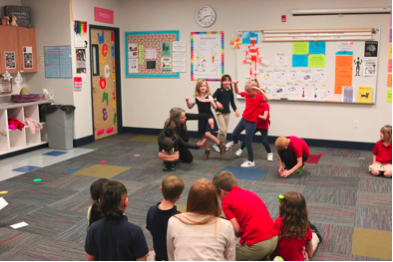 Break into groups and give students time to work. Give each group an envelope with small weather symbols in it for the students to use as they create their weather forecasts. Each section has approximately four types of weather that can be heard in the music. The students do not need to use all of these types of weather in their forecasts, though. Aim to have each group use two types of weather in their forecast, and if they use more, that is a bonus. The envelopes should have only the four weather symbols used for their specific season, but with several copies of each of those four types of weather. Summer includes sunny/heat wave, cloudy, thunder/lightning storm, and hail. Autumn includes sunny, cloudy/foggy, light rain/rainbow, and blustery wind (windy). Winter includes freezing, bitter wind (windy), snowy, and sunny.
Break into groups and give students time to work. Give each group an envelope with small weather symbols in it for the students to use as they create their weather forecasts. Each section has approximately four types of weather that can be heard in the music. The students do not need to use all of these types of weather in their forecasts, though. Aim to have each group use two types of weather in their forecast, and if they use more, that is a bonus. The envelopes should have only the four weather symbols used for their specific season, but with several copies of each of those four types of weather. Summer includes sunny/heat wave, cloudy, thunder/lightning storm, and hail. Autumn includes sunny, cloudy/foggy, light rain/rainbow, and blustery wind (windy). Winter includes freezing, bitter wind (windy), snowy, and sunny.
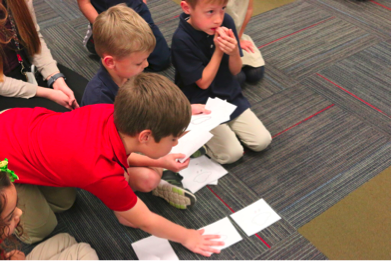 After students finish their group work and are ready to perform, give each group a second envelope that has all of the weather symbols that are found in the various movements from The Four Seasons listened to by the groups. Each season group will perform their dance. While they are dancing, the other groups should see if they can figure out what weather type they hear and see happening within the season. Each group will designate a leader, and the groups will silently help the leader place the weather symbols in order on the floor to create a forecast based on what they see in the dance and what they hear in Vivaldi’s music.
After students finish their group work and are ready to perform, give each group a second envelope that has all of the weather symbols that are found in the various movements from The Four Seasons listened to by the groups. Each season group will perform their dance. While they are dancing, the other groups should see if they can figure out what weather type they hear and see happening within the season. Each group will designate a leader, and the groups will silently help the leader place the weather symbols in order on the floor to create a forecast based on what they see in the dance and what they hear in Vivaldi’s music.
At the end of each performance, compare the groups’ weather forecasts to see if they match or if the groups heard and saw things a little differently.
Here are some question stems and danceable ideas that teachers can share with the students as they work in their individual groups.
Question stems to help students begin exploring movement
- What shape(s) can represent . . . ?
- What are qualities of movement that would show . . . ?
- How can we show . . . with our bodies?
How can we show the energy of . . . ?
--PAGEBREAK--
| Weather | Danceable Movement Ideas |
|---|---|
| Sunny | Bring arms up into a big circle surrounding the head. Then reach and stretch with arms representing rays of the sun. |
| Breezy | Move with a medium energy, using swinging, swaying, and spinning motions of the arms and body. |
| Rainy | Tap fingers gently on the floor, making a gentle rain sound. Bring hands up above the head and wiggle fingers while slowly lowering hands down to a lower level. |
| Thunder/lightning storm | Dance using explosions of energy and sharp percussive motions. |
| Partly Cloudy | Some students make shapes representing clouds. Other students may represent sun rays by reaching and stretching through the negative (empty) spaces in the clouds. |
| Sunny/heat wave (temperature) | Bring arms up into a big circle surrounding the head. Imagine being so hot that you slowly melt to the ground. Find interesting ways to move in as you slowly lower your body to the ground. |
| Cloudy (thunder clouds in the distance) | Move arms into low-level, flat, stretching shapes for stratus clouds. Move arms in high-level wispy motions for cirrus clouds. Shape arms in big, puffy, low-level curving ways for cumulus clouds. The movements of rising, floating, falling, and bursting may also be explored as ways that clouds move. |
| Hail | Find clapping rhythms with two hands. Have a student clap a pattern and have the group echo the rhythm. |
| Cloudy/foggy | Move arms into low-level flat, stretching shapes for stratus clouds. Move arms in high-level, wispy motions for cirrus clouds. Shape arms in big, puffy, low-level, curving ways for cumulus clouds. The movements of rising, floating, falling, and bursting may also be explored as ways that clouds move. |
| Light rain (and a rainbow) | For rain, tap fingers gently on the floor, making a gentle rain sound. Bring hands up above the head and wiggle fingers while slowly lowering hands down to a lower level. For a rainbow, move hands from the right side of the body up, over, and down to the left side of the body in a gentle swaying motion. |
| Blustery wind (windy) | Move with high motion and energy using swinging, swaying, and spinning motions of the arms and body. |
| Freezing (temperature) | Take all the energy and hold it still like frozen water (ice/nothing moves). Make frozen shapes interesting by using curved, straight, bent, and twisted lines with your body. |
| Bitter wind (windy) | Bitter wind is very cold; bring your body parts toward your core (the middle) to keep warm. Walk as if you are bracing against a bitter wind, while pulling your arms in close for warmth. Explore the speed of walking when a strong, bitter wind is pushing against you. Walk with a pushing, forward motion. |
| Snowy | Begin in a high shape and find floating, turning, gentle ways of moving to a low level. Come to the ground and make a shape that is interesting and unique. (This is an ideal time to explain that each snowflake is different, just as each person is different.) Variety makes things interesting. |
Learning Objectives
- Identify characteristics of weather.
- Record weather information within each season.
- Listen and move to music, responding to instrumentation, tempo, and pitch.
- Identify the form of a piece of music by using pictures to represent specific sections heard.
- Demonstrate movements that are representative of an idea or stimuli.
- Create and perform a sequence of movements.
- Ask and answer questions about key details in an informational text.
Utah State Board of Education Standards
This lesson can be used to meet standards in many grades and subject areas. We will highlight one grade’s standards to give an example of application.
Grade K Science with Engineering Education (SEEd)
- Strand K.1: WEATHER PATTERNS
Weather is the combination of sunlight, wind, snow or rain, and temperature in a particular region at a particular time. People measure these conditions to describe and record the weather to identify patterns over time. Weather scientists forecast severe weather so that communities can prepare for and respond to these events. Sunlight warms Earth's surface.- Standard K.1.1: Obtain, evaluate, and communicate information about local, observable weather conditions to describe patterns over time. Emphasize the students' collection and sharing of data. Examples of data could include sunny, cloudy, windy, rainy, cold, or warm. (ESS2.D)
Grade K Music
- Standard K.M.P.3.
- Respond to the conductor to start, stop, and stay together.
- Standard K.M.R 1: Listen to and interact with a variety of contrasting music while recognizing steady beat, repeating patterns, and expressive elements.
- Standard K.M.R.2: Describe feelings conveyed by a music selection and identify elements in a music selection that elicit feelings.
- Standard K.M.CO.2: Describe how music relates to personal and social experience.
- Standard K.M.CO.4: Explore and demonstrate learning in another content area through music.
Grade K Dance
- Standard K.D.CR.2: Explore movement inspired by a variety of stimuli.
- Standard K.D.P.5: Demonstrate contrasts in tempo by matching movement to a given beat.
- Standard K.D.R.1: Select movements from a dance, and explain how the movements suggest an idea.
- Standard K.D.CO.2: Describe and demonstrate movements organized around a specific topic.
Grade K English Language Arts
- Reading, Informational Text Standard 1: With prompting and support, ask and answer questions about key details in a text.
- Reading, Informational Text Standard 2: With prompting and support, identify the main topic and retell key details of a text.
- Reading, Informational Text Standard 4: With prompting and support, ask and answer questions about unknown words in a text.
- Speaking and Listening Standard 2: Confirm understanding of a text read aloud or information presented orally or through other media by asking and answering questions about key details and requesting clarification if something is not understood.
Equipment and Materials Needed
- Pluckrose, Henry Arthur. Seasons. Milwaukee, WI.: Gareth Stevens, 2001.
- Open space for movement
- A current hourly weather forecast (digital or printed)
- Larger weather symbols for the board (PDF)
- Weather symbols for specific season forecasts printed, cut, and put in envelopes for each group to use (Spring PDF, Summer PDF, Autumn PDF, Winter PDF)
- All of the weather symbols printed, cut, and put in envelopes for each group to use
- Small hand drum to signal certain dance movements (optional)
- Picture of Antonio Vivaldi
- The Four Seasons listening guide PDF, detailing the specific movements from each concerto used in this lesson (for teacher reference only)
- Three devices to listen to Vivaldi’s music, one in each group (CD player, iPad, Chromebook, iPod with speakers, or other classroom resources)
- Recordings of Vivaldi’s The Four Seasons (any recording will work, but the links listed below are free online and the listening guide timings are based on these recordings)
- Music
Additional Resources
Lesson extensions might include the following:
- Create your own weather composition based on actual weather records you observe as a class. Create an hourly forecast using the weather pictures, which will then create the outline for the music composition. If there are four different types of weather recorded, divide the class into four groups and let each group make decisions about one specific type of weather (melody, rhythm, patterns, and so forth.) The sounds used in the composition could be sounds you can make with your voice, your body, classroom instruments, or fun-sounding objects around the classroom.
- Compare and contrast the sunny weather in all four seasons while listening to these same movements from Vivaldi's The Four Seasons.
- Additional lesson plans can be found at the following:
- Here is a website that lists more musical compositions depicting the seasons and types of weather: https://www.azcentral.com/story/entertainment/music/2016/10/26/weather-classical-music/91751698/.
- Here is the Kindergarten SEEd Open Education Resource Textbook: https://emedia.uen.org/courses/utah-oer-textbooks-kindergarten-seed/view
Image References
Image 1: https://englishvictorjara4.blogspot.com/2013/01/the-four-seasons.html
Images 2–11: James Huston
Weather Symbols:

www.education.byu.edu/arts/lessons
 Download
Download